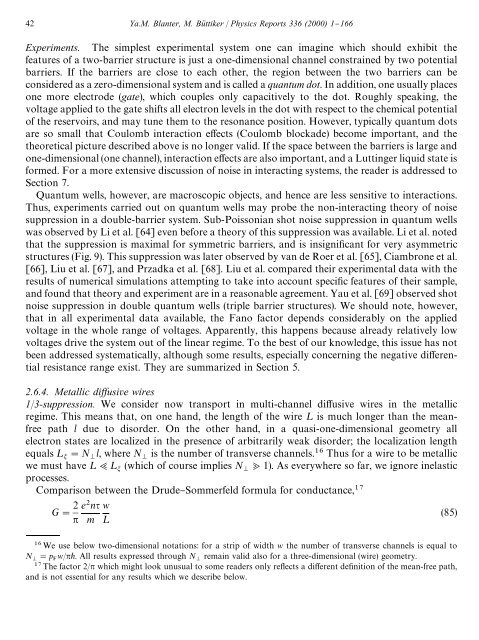shot noise in mesoscopic conductors - Low Temperature Laboratory
shot noise in mesoscopic conductors - Low Temperature Laboratory
shot noise in mesoscopic conductors - Low Temperature Laboratory
You also want an ePaper? Increase the reach of your titles
YUMPU automatically turns print PDFs into web optimized ePapers that Google loves.
42 Ya.M. Blanter, M. Bu( ttiker / Physics Reports 336 (2000) 1}166<br />
Experiments. The simplest experimental system one can imag<strong>in</strong>e which should exhibit the<br />
features of a two-barrier structure is just a one-dimensional channel constra<strong>in</strong>ed by two potential<br />
barriers. If the barriers are close to each other, the region between the two barriers can be<br />
considered as a zero-dimensional system and is called a quantum dot. In addition, one usually places<br />
one more electrode (gate), which couples only capacitively to the dot. Roughly speak<strong>in</strong>g, the<br />
voltage applied to the gate shifts all electron levels <strong>in</strong> the dot with respect to the chemical potential<br />
of the reservoirs, and may tune them to the resonance position. However, typically quantum dots<br />
are so small that Coulomb <strong>in</strong>teraction e!ects (Coulomb blockade) become important, and the<br />
theoretical picture described above is no longer valid. If the space between the barriers is large and<br />
one-dimensional (one channel), <strong>in</strong>teraction e!ects are also important, and a Lutt<strong>in</strong>ger liquid state is<br />
formed. For a more extensive discussion of <strong>noise</strong> <strong>in</strong> <strong>in</strong>teract<strong>in</strong>g systems, the reader is addressed to<br />
Section 7.<br />
Quantum wells, however, are macroscopic objects, and hence are less sensitive to <strong>in</strong>teractions.<br />
Thus, experiments carried out on quantum wells may probe the non-<strong>in</strong>teract<strong>in</strong>g theory of <strong>noise</strong><br />
suppression <strong>in</strong> a double-barrier system. Sub-Poissonian <strong>shot</strong> <strong>noise</strong> suppression <strong>in</strong> quantum wells<br />
was observed by Li et al. [64] even before a theory of this suppression was available. Li et al. noted<br />
that the suppression is maximal for symmetric barriers, and is <strong>in</strong>signi"cant for very asymmetric<br />
structures (Fig. 9). This suppression was later observed by van de Roer et al. [65], Ciambrone et al.<br />
[66], Liu et al. [67], and Przadka et al. [68]. Liu et al. compared their experimental data with the<br />
results of numerical simulations attempt<strong>in</strong>g to take <strong>in</strong>to account speci"c features of their sample,<br />
and found that theory and experiment are <strong>in</strong> a reasonable agreement. Yau et al. [69] observed <strong>shot</strong><br />
<strong>noise</strong> suppression <strong>in</strong> double quantum wells (triple barrier structures). We should note, however,<br />
that <strong>in</strong> all experimental data available, the Fano factor depends considerably on the applied<br />
voltage <strong>in</strong> the whole range of voltages. Apparently, this happens because already relatively low<br />
voltages drive the system out of the l<strong>in</strong>ear regime. To the best of our knowledge, this issue has not<br />
been addressed systematically, although some results, especially concern<strong>in</strong>g the negative di!erential<br />
resistance range exist. They are summarized <strong>in</strong> Section 5.<br />
2.6.4. Metallic diwusive wires<br />
1/3-suppression. We consider now transport <strong>in</strong> multi-channel di!usive wires <strong>in</strong> the metallic<br />
regime. This means that, on one hand, the length of the wire ¸ is much longer than the meanfree<br />
path l due to disorder. On the other hand, <strong>in</strong> a quasi-one-dimensional geometry all<br />
electron states are localized <strong>in</strong> the presence of arbitrarily weak disorder; the localization length<br />
equals ¸ "N l, where N is the number of transverse channels. Thus for a wire to be metallic<br />
<br />
we must have ¸;¸ (which of course implies N
















